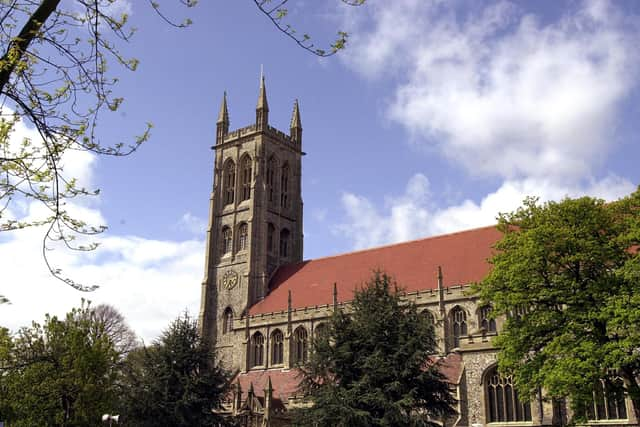How Portsmouth, Southsea, Fratton, Cosham and other towns in the area got their names
and live on Freeview channel 276
Parts of Portsmouth were even featured in the Domesday Book back when it was penned in the 11th century.
Dubbed ‘the great survey’ it was taken in 1086 and recorded much of England and part of Wales at the request of William the Conqueror.
Advertisement
Hide AdAdvertisement
Hide AdWhich means that the city and the surrounding towns have been around for so long that most of us have no idea where the places got their names from.


If you’ve ever wondered why Fratton is called Fratton, or where Portsmouth comes from, here’s what you need to know about the origins of the place names in our area:
Portsmouth
According to the University of Nottingham the old English name for our city was Portesmuða which derived from the port – meaning a haven or a harbour – and mūða – meaning the mouth of a large river, an estuary.
In his book A History of the English-Speaking Peoples, Winston Churchill wrote that Portsmouth was founded by a man called Port who was a pirate in 501AD.
Advertisement
Hide AdAdvertisement
Hide AdHowever it is commonly believed that Portsmouth, the city as it is today, was founded by Norman lord Jean de Gisors after he purchased the manor of Buckland (now part of the city) in 1180. This original settlement was in what is now called Old Portsmouth.
Baffins
Turned into a residential area in the 1930s, this part of the city gets its name from Baffins farm which had stood on the land from the 12th century.
Baffins Pond and Tangier Field are the only surviving remnants of its rural past.
Buckland
This area of the city has been settled for many centuries and was featured in the Domesday Book.
Advertisement
Hide AdAdvertisement
Hide AdIt appeared under the name Bocheland. Over time this changed to Buckland but has nothing to do with bucks, male deer.
Copnor
Another of the parts of the city that featured in the Domesday Book nearly 1,000 years ago.
It was featured under the name of Copenore but over time the letter e was dropped from the name.
Cosham
This Portsmouth suburb dates back to the days of the Domesday Book, when it appeared under the name Cos(s)eham.
Advertisement
Hide AdAdvertisement
Hide AdThe name is of Saxon origin as shown by the ham suffix in the name.
It meant Cossa's homestead.
Overtime the name was simplified to Cosham with the extra s and the e being dropped.
Drayton
Another ancient part of the city, it was featured in the Domesday Book under the name of Draiton.
In the 14th century it was written as Dreton.
Overtime it has evolved with the e being replaced with an a and a y.
Advertisement
Hide AdAdvertisement
Hide AdFratton
Originally this residential area of Portsmouth was known as Froddington and appeared in the Domesday Book under that name.
It was of Saxon origin and it originally meant ‘Frodda's Farm’ or ‘Frodda's village’.
A pub on Fratton Road is called the Froddington Arms honoured on its old name.
Overtime Froddington evolved and become Fratton.
North End
Advertisement
Hide AdAdvertisement
Hide AdThis part of Portsmouth developed rapidly after a horse-drawn tram route was opened between Portsmouth and Cosham.
It derives its name from being at the time a northern expansion of the village of Kingston (which is now part of the city as well), forming the ‘northern end’ of Kingston.
This evolved to simply North End over time.
Milton
This area of Portsmouth gets its name from the Saxons.
It was originally known as Middletūn which meant ‘middle settlement’ because it was half way between the settlements of Froddington and Eastney.
Post-1066 it was simplified to Middleton and it is likely that over the centuries it evolved to Milton as a result of local dialects.
Paulsgrove
Advertisement
Hide AdAdvertisement
Hide AdThis part of the city used to be a small hamlet for many years, it was on the road between Portsmouth and Southampton.
There is no definitive origin for the name, however one possibility is believed to be that it was named after St Paul who according to legend landed at the site at the start of his visit to Britain when it was part of the Roman Empire.
Another possible origin for the name Paulsgrove, believed to be more likely, is that old maps showed the area labelled as Pals Grave – meaning it could have been the resting place of a local chief.
It developed as a fashionable seaside resort during the Victorian era.
Advertisement
Hide AdAdvertisement
Hide AdSouthsea originally was known by the name Croxton Town, as it was built on land owned by Thomas Croxton.
However later in the 19th century it changed its name and adopted Southsea after the castle in the area.
The castle dates back to the Tudor era and was built by Henry VIII as part of his defence program.
Comment Guidelines
National World encourages reader discussion on our stories. User feedback, insights and back-and-forth exchanges add a rich layer of context to reporting. Please review our Community Guidelines before commenting.
